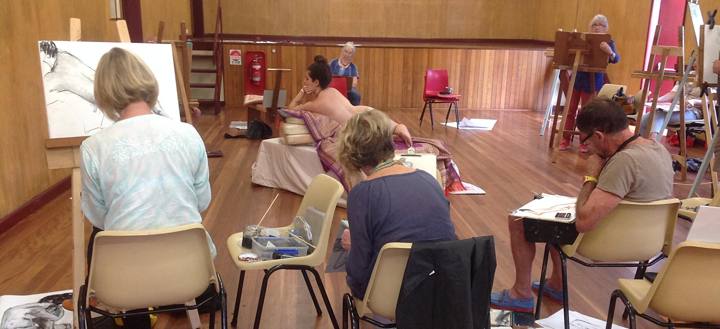Beyond individual ability, drawing holds benefits accessible by all who are willing to see anew
Every week, a group of adults varying in age and background meets at the building “Kincumber Village School of Arts” on the central coast, north of Sydney. They gather to practise the skill of life drawing: to sketch the human figure by observing a live model. It’s a technique many are aware of but don’t fully understand, like the concept of drawing itself.
To draw is a natural activity. As soon as we realised that we could make marks as children—say, in sand, or on a foggy window—we did. Drawing is essentially the trace left behind by movement.
But if drawing is so natural and something that virtually every child does, why don’t most of us practise it as adults? We passed through the same stages of development in drawing, in the same order: a random scribble followed by controlled scribble. Then, with encouragement from adults, we started to assign meaning to these marks: loops with spots inside them became faces, and lines radiating from these “faces” became arms and legs. Soon we were telling increasingly complex stories with our pictures. When we saw photographs and other lifelike images, we tried to make our own drawings look real. What happened next depended on how much encouragement we received from adults around us and, to a certain extent, on our natural talent. This is what is often referred to as the “crisis of realism.” We either broke through and developed our skills further, or we abandoned drawing, telling ourselves it wasn’t a skill we possessed.
Unfortunately, only a small percentage of adults believe they can draw, and consequently do draw. Yet drawing is an important activity for everyone. It encourages seeing without labelling. Normally when we look around us, we categorise things, often unconsciously: “That’s a person; that’s a tree.” Even when we look at a face, we usually see it as the sum of separate facial features. This is an important skill because it allows us to make sense of the world around us by comparing new visual sensations with similar ones stored in our memory without overloading our brains. But by doing this we miss out on the aesthetic experience, which is seeing just for the pleasure of seeing. These different modes of observation are sometimes called the verbal and non-verbal. Generally speaking, the most successful drawings engage the non-verbal mode.
The verbal mode is logical, sequential, rational, objective and analytical (seeing things as sums of parts). The non-verbal mode is intuitive, non-sequential, irrational, subjective and holistic (seeing things as indivisible wholes). If you have ever felt inadequate about drawing, it may be because you’ve been relying on the verbal mode. One way to encourage the non-verbal is to copy a photo of a person upside down. The verbal part of our mind won’t know what to do with this visual stimulus because nothing looks familiar. Therefore, the non-verbal can take over. Interestingly, the drawing that results will probably look better than if you had drawn the photo right-side up.
One question that pops up in relation to life drawing is “Why do artists draw nudes?” The conventional answer is that to paint a person clothed, you need to know what’s going on under the clothes. But this explanation avoids the obvious question of sexuality. (Drawing other things, like mountains or pumpkins, can also be sexual, or at least sensual. The connection just isn’t as clear.)
Drawing is a sensual activity because drawing a line is akin to touch. One could easily imagine, as the pencil makes marks on paper representing, say, the small hollow below a model’s shoulder, that the pencil is actually following the contours of that hollow. There is also a sense in which the artist is stealing the model’s privacy. This points to the paradox in life drawing: the model is both an object and a person.
The Kincumber Life Drawing group meets every Friday between 10am and 12.30pm, at Kincumber Village School of Arts, at the corner of Empire Bay Drive and Tora Avenue, Kincumber. A typical session begins with a few short poses before longer poses between 20 and 30 minutes. The model could be either female or male. The group is accepting and supportive, and a wide range of styles and experience levels are represented. For more information, contact Jonathan.
Based on an article written by Jonathan Cooper and Zoë Cooper, in a Canadian magazine CV Collective
